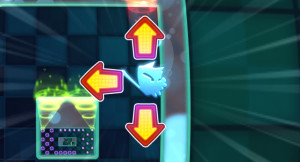When I start working on a new game, I make a few core rules to use later on as DNA pillars. These basic rules help to take all my decisions down the road.
As we are making Pix the Cat @Pastagames, I learned that this process is flawed.
Here is why:
When you play an action game, the emotions you feel come from the connections between your mind and body. You might even come close to a mantra-like experience and the bubble you get drawn into is our ultimate goal as (action games) designers.
There is a lot to discover when building. “Better” ideas bloom and ripen. If these ideas contradict your initial intentions, you will be frustrated if you stick too closely to your core rules.
Logical bottom-up creative process helps to build a coherent game but can get in the way of emotional lift-off.
When writing a description about a game; it is better to describe the experience a player will go about rather than listing the number of characters, levels, environments…
I now understand that during a creative process, it is much more fruitful to set unwavering emotional targets rather than cast-iron core rules. Wings before roots.
Staying on the emotional course is more important than being coherent and structured. Accepting to do “illogical” things is often hard, but it can contribute to reaching your emotional targets. Players may end up disoriented but it is acceptable considering the added emotional value.
For example, a basic rule of Pix the Cat was that when Pix collides with a wall, it kills him. It was meant as a tough rule (taken from Snake) that ensured constant flow and danger.
This rule was used to decide how the Cat turns in curves; it guided the positioning of collectibles for the level design; it contributed to the collision rules with the tail you build up…
It unfortunately forced us to keep Pix’s speed pretty low. I held on to it because it vouched for the Die & Retry aspect that was very important for the player’s frustration/satisfaction balance.
It took time to break my mold and understand that the emotional benefit of increasing the Cat’s speed was more valuable to the player’s experience than the initial balance and intentions. Increasing the speed added another level of concentration and contributed to the mantra-zone pleasure.
We therefore changed the core-rule to allow greater speed by being more tolerant on the collisions (using a long slow motion before impact).
We even ended up removing this rule entirely in the multiplayer ARENA mode. The satisfaction of “finishing off” your opponent became more valuable than the game’s DNA. Though illogical, we chose to reduce the situations in which a Cat dies because of his own mistake to avoid the “You won only because I lost” factor. We wanted that Victory was obtained by the winner’s action directly!
The collision-with-walls rules are now different in each mode and very un-elegant: here walls kills you, there they stop you without damage, here there is a slow motion that protects you, there direct crash…
We sacrificed consistency but made the player experience better overall.
From now on, I will start by crafting top-down emotional targets that should resist production discoveries, and only then basic bottom-up rules that can be tampered with if necessary.
Until I change my mind…


Si je poste un commentaire, est-ce que ça me débloque un achievement ?
Trop cool !
Bonne question…
cool
J’ai rien comprendre
Bonne tentative… mais il faudra encore gratter pour tous les trouver ! C’est comme les pokémons… ou pas…
Je chercher je cherche, il me manque le corrector, le egg et l’optimistic (et du coup, le champion j’imagine)
Je veux mon achievement
achievment test
ups… sorry ^^’
but i’I found it…